Text

a pair of socks from the archive of the the hiroshima peace memorial museum
from “here and now: atomic bomb artifacts, ひろしま/hiroshima 1945/2007—,” by ishiuchi miyako
3 notes
·
View notes
Text
The Price of Peace
Before the war, Hiroshima was a sizable city known for its castle town were on par with Himeji or Osaka Castle. During the war, it became a focal point of military activity with large depots of military supplies. Not too far away was the location for where the Akatsuki Corps, a special cadet system set up by the Army as the war situation grew more severe. These young men were trained daily in preparation for suicide attacks against the Allied Forces.
Everything changed, however, on 6th August 1945 when the United States of America dropped the 'Little Boy' atomic bomb and killed approximately a hundred thousand people in the blast, and upending thousands more in the intervening years.
With this one mighty blow, the death knell of World War II was rung with the Allied Forces anointed the winners.
But what was the price for this victory?
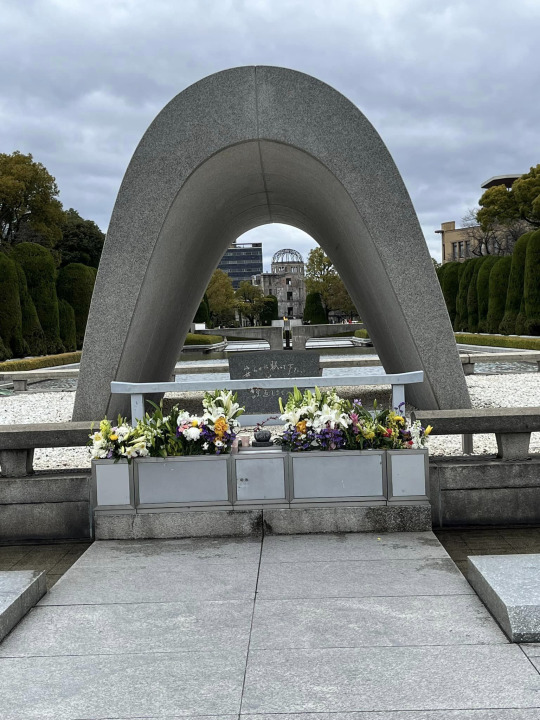

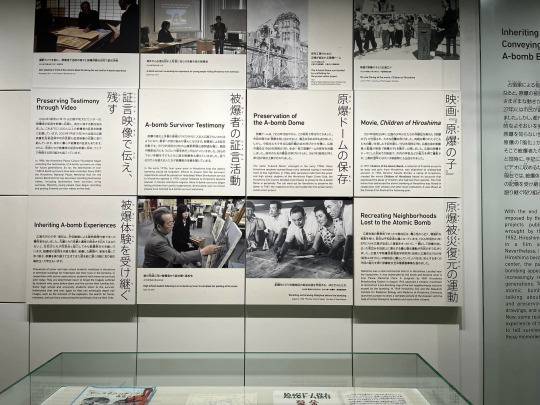
As the film Oppenheimer opined, perhaps the creation of the atomic bomb had ignited the world into a downward spiral to destruction. Humanity was so beholden with the idea of if they 'could' create such a bomb there was too little consideration on whether we 'should.' War is tribalism at its best, where we paint those like us as the 'good guys' and demonise the opposing side.
We might all be humans struggling to live on this planet we call home but should someone come to disrupt the equilibrium we live in, humans are very quick to lash out and attack those they feel are too 'different.' In societies of old, blame was laid on 'outsiders' for all manners of ills. The witch hunts are one such example.
In any case, the creation of the atomic bomb led to several more weapons of mass destruction being constructed as a means to threaten and deter others despite attempts from the survivors to prevent their proliferation. A macrocosm of a race to have the bigger weapon or to 'protect' one's interest because you see the neighbour across the street has bought a gun.
As an aside, America's gun laws are a mess and if the world ever needs to see what stocking weapons of mass destruction could lead to, look no further than the mass shootings in America that happen almost every day.
It only takes one imbecile (or, in the case of nuclear weapons, a nation of imbeciles) to plunge the world into disrepair.
Anyways, what I wanted to say was that listening to the testimonies and reading the stories of those who lived through the endless days of Hell after the atomic bomb, it became very hard for me to reconcile why anyone would want to keep nuclear weapons on hand. The pain and death it caused. The aftereffects due to radiation. And the shattering effect it had on families as they grappled with their loss.
No dispute, be it over bruised pride or resources, should ever need the use of nuclear weapons for the victory attained would be Pyrrhic at best. Even the Akatsuki Corps members, boys who were trained to give up their lives in service to their nation, could not equate the destruction of HIroshima with 'glorious' war.
This was all laid bare to me at the Atomic Bomb Museum and the Hiroshima National Peace Memorial Hall for the Atomic Bomb Victims.

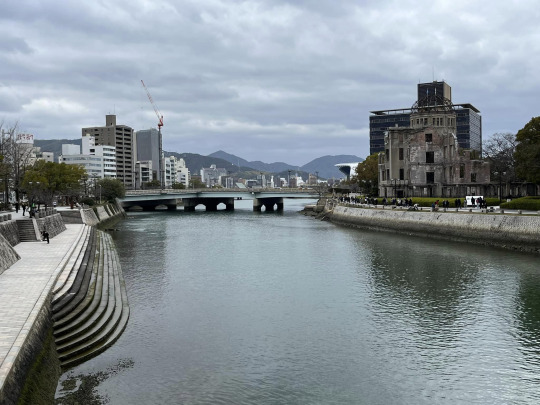

Now, I'm not sure how telling it is but while Hiroshima had a large number of peace tourists visiting the cenotaph and the Atomic Bomb museum, there hadn't been as many visitors to Nagasaki. Rather, Nagasaki had more local tourists flocking to the region wishing to try out specialty dishes such as champon noodles and castella.
After appreciating the gravity of the events that shaped modern Japan, including the Atomic Bomb Dome, bleachpanda and I enjoyed a very noodle-heavy okonomiyaki at a nearby restaurant before we headed to Hiroshima Castle.
Hiroshima Castle was established by Mori Terumoto in 1589 at the delta of the Otagawa River. In 1600, following the battle of Sekigahara, Terumoto was forced to retreat and Fukushima Masanori from Kiyosu took control of the castle. However, after restoring the castle following the flood of 1619 without permission from the Tokugawa shogunate, Masanori was dismissed. Asano Nagaakira then became lord of Aki and the Asano family continued to hold this position up until the Meiji restoration.
Inside Hiroshima Castle, we climbed, reading about its history from the exhibits until we managed to reach the top and looked out on the city. After seeing the tragedy of the atomic bomb, it was nice to learn some of Hiroshima's early history as a bustling city and its ties to the Tokugawa Shogunate before its abolition.
Despite the cloudy day, Hiroshima glimmered before us int he afternoon light.
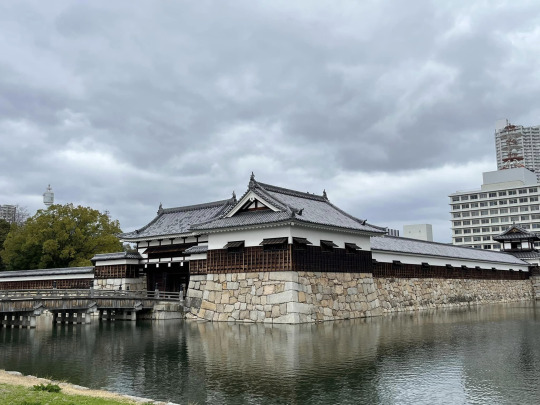
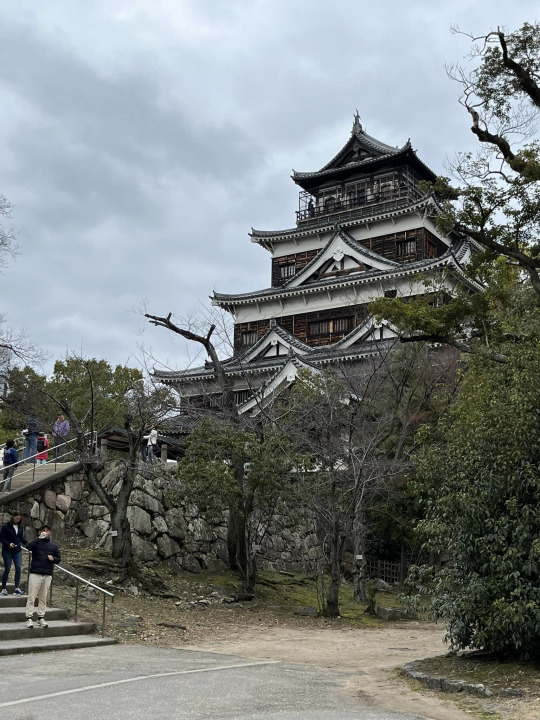
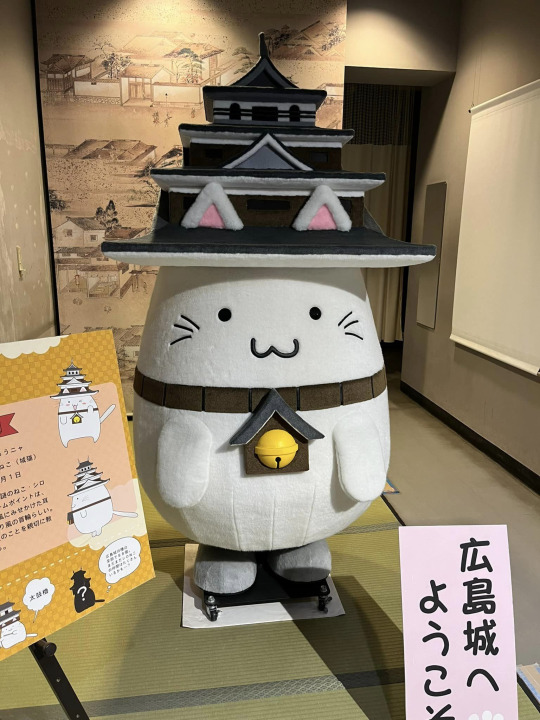
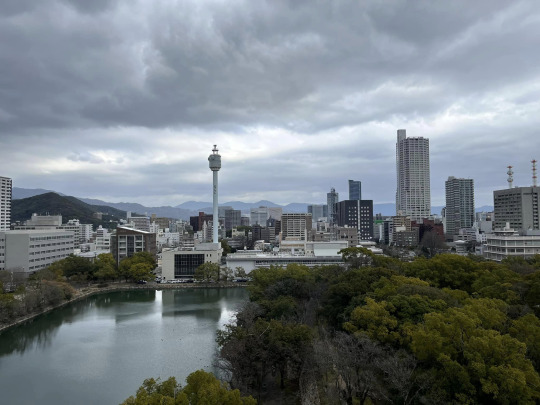
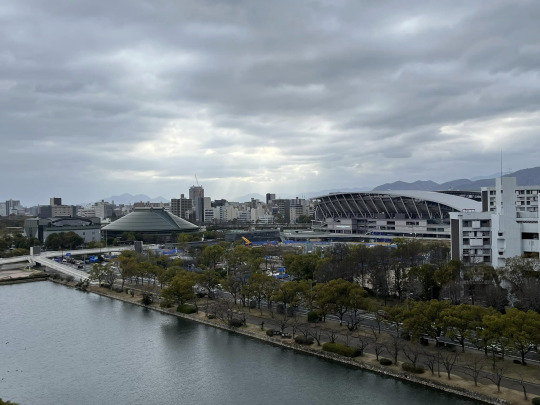
Our key tourist sites finished, bleachpanda dragged me to Animate - a weeb store filled with gacha capsules on the ground floor with figurines (including Ichiban Kuji prizes), mang, doujinshi and other merchandise from popular anime available for purchase.
While I picked out some tasteful Detective Conan acrylic stands, bleachpanda ended up buying a Demonslayer shirt that cost more than half of my purchase! Truly, she is a fiend who cannot be stopped. And will then turn around the next moment to blame an innocent, such as myself, for her extravagant spending!
As the day drew to a close, bleachpanda and I ended the day at Sensui, a restaurant at the Hilton. The two of us got the Onomichi set (a place I would have liked to visit because Yakuza 6: The Song of Life had its early story beat set here. And it is where we get the mascot Ono Michio! With his charming hassaku face, steamy Onomichi ramen hat, cute fish pouch and cool boots, vital for any fisherman, and his cool and trendy Ono shirt!) and which cost us approximately 100,000 yen each!
Given half our holiday was over anyways, i thought it a nice touch to splurge a little and treat ourselves. Tomorrow, after all, was another day of transit as we headed further east to Osaka. And while I wouldn't be able to see the sights of Miyajima or Onomichi, I did have one thing I was excited for.
Universal Studios Japan, here we come!
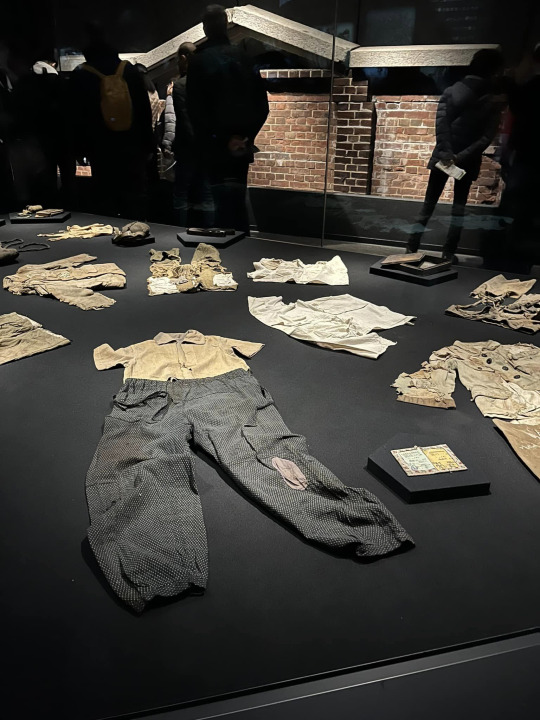
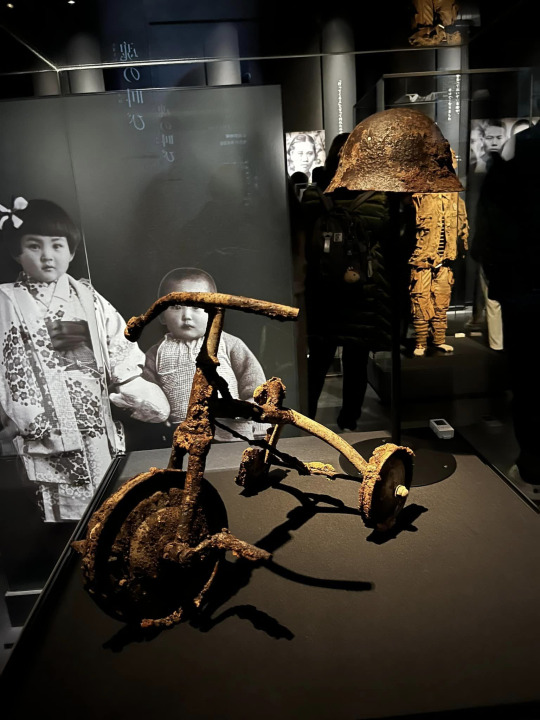
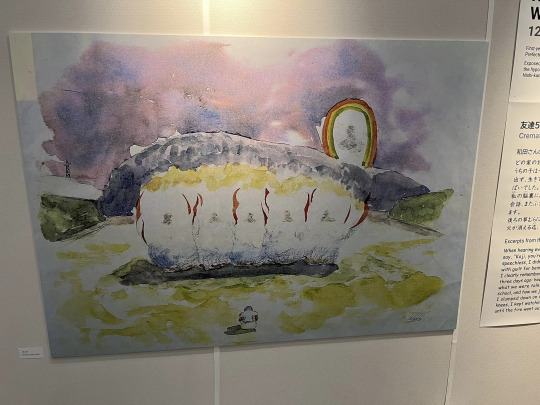
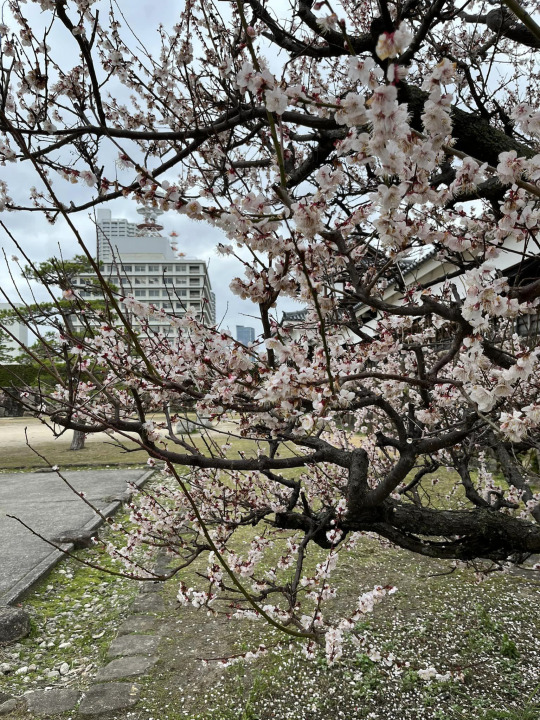
#personal blog#travelling#travel blog#hiroshima#atomic bomb museum#peace memorial hall#hiroshima castle#animate
12 notes
·
View notes
Text

just sharing one of the most devastating comments i've ever read (green highlight/s) don't mind me
#included the parent comment for context obv#god.......it all traveled that far#im not doing good i also went and looked up the hiroshima memorial peace museum bcus i was thinking abt the wax figures again#they removed them apparently#the year i visited was the year it was decided they'd be removed but it took them another like 3-5 years to actually do it#anyway. byeee
1 note
·
View note
Text
#ItIs90SecondsToMidnight #IWantMyPlanetBack "Every year on August 6th we’d go to school, visit the Peace Memorial Park & Peace Memorial Museum, listen to #atomicbombsurvivors who were active as storytellers, and learn countless things about peace."https://hiroshimaforpeace.com/en/its-important-to-continue-to-spread-the-message-that-this-tragedy-must-never-be-repeated-again/
#Hiroshima Bombing#It Is 90 Seconds To Midnight#I Want My Planet Back#Atomic Bomb Survivors#Peace Memorial Park#Peace Memorial Museum
0 notes
Text
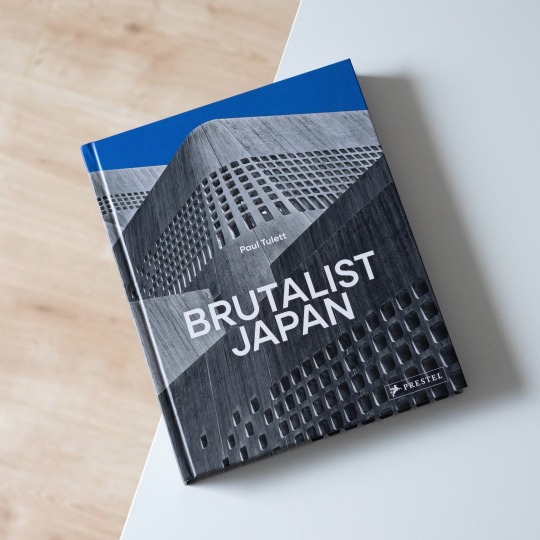
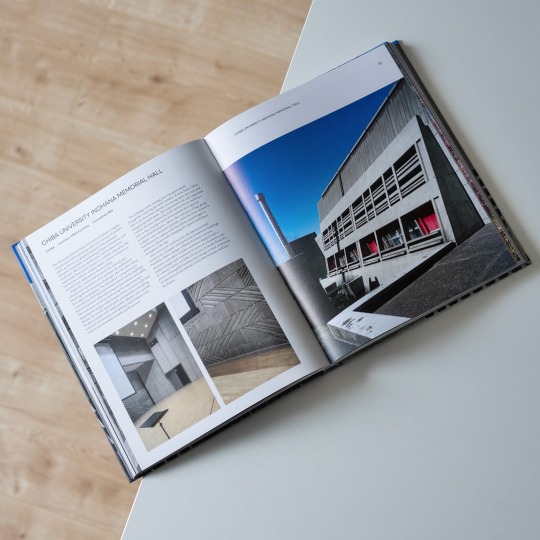
The built manifestations of Brutalism, despite their omnipresence on social media, remain controversial: especially in Europe they are loved by some and hated by many. In other parts of the world opinions aren’t as polarized and Brutalism simply a part of the built environment, e.g. in Japan. Okinawa-based photographer Paul Tulett has been exploring the Japanese brutalist heritage for years and in his new book „Brutalist Japan“, recently published by Prestel, points to the particular appeal concrete had in postwar Japan: it offered seismic safety, was resistant to termites and easy to pour in form and via the shuttering boards also left room for the skilled Japanese wood crafts. At the same time the Japanese tradition for leaving natural materials rough and raw played in the hands of „béton brut“ that, as Tulett explains, became „béton nécessaire“.
The former’s gradual aging and the acceptance thereof agains roots in Japanese tradition, i.e. the concepts of „wabi sabi“ and „mono no aware“ which embrace the beauty of imperfection and describe the ambivalent awareness of the fleeting nature of beauty. Against this background and Tulett’s introduction to Japanese philosophies it becomes easier to understand why Brutalism is a lot less controversial in Japan than it is in other parts of the world and never disappeared. Accordingly the buildings gathered in „Brutalist Japan“ date from the 1950s to the present day and offer a comprehensive panorama of Brutalism in Japan: in brilliant photographs Tulett shows classics like Kenzo Tange’s Hiroshima Peace Memorial Museum (1955) and Setagawa Ward Office (1959) or Le Corbusier’s National Museum of Western Art (1959) but also a plethora of little-known buildings. And they are compelling: the fortress-like Tanimura Art Museum (1983) by Togo Murano, the Keihan Uji Station (1995) by Hiroyuki Wakabayashi or the Okinawa Prefectural and Art Museum (2007) by Ishimoto and Niki Associates demonstrate the masterful use of raw concrete while also dealing with Japanese history and traditions.
This beautifully crafted mix of buildings makes the book a great read and an eye-opening survey of Japanese Brutalism. Highly recommended!
156 notes
·
View notes
Text

Kenzo Tange Hiroshima Peace Memorial Museum exterior, memorial 1952 Image: 1959 Photographer: Ezra Stoller
99 notes
·
View notes
Text
Your Homicidols Weekender #413
This will be the last Weekender filed from Japan for a bit. My visit is winding down. I spent the last couple of days in Hiroshima which, despite being the home of YABACUBE and PLANCK STARS , has not included any idol-related activities. I did visit the Peace Park, Bomb Dome, and Memorial Museum yesterday which was a truly unforgettable experience that will resonate in my heart always. I highly…
2 notes
·
View notes
Text
I have a lot of analysis feelings about how Oppenheimer is a lone genius narrative and male power fantasy—
including the male gaze shots for Florence Pugh’s nude scenes… (when the real woman she was based on, Jean Tatlock, was likely bisexual or lesbian)…
but this article below really brings a perspective people need to hear. Discussing the reality and consequences of the a-bomb project, so conveniently excluded from the film:
“For Lai, watching the point of view that Hollywood deemed worthy of a $100 million budget, “I felt very invisible and lonely for another three hours dedicated to a white male genius.”
I would also recommend everyone visit the Hiroshima Peace Memorial Museum website and look at the exhibits and artifacts.
Educate yourself on what the aftermath really looked like and the experiences of those affected.
#I don’t want film bros to come at me#but the movie really is only a small chunk of the story#i taught ww2 for art history#and seeing the peace memorial stuff convinced me wholy#we never want to see this destruction ever again#amethyst rambles#movie tag#oppenheimer
25 notes
·
View notes
Text
Hi everyone!
I have been seeing a lot of Barbenheimer memes on SNS recently.
Please do not forget that the atomic bomb is a terrible weapon that took many lives in an instant and some people are still suffering from the aftereffects of nuclear weapons.
This meme is NEVER funny.
Atomic bombs and mushroom clouds should NEVER be jokes.
Please stop posting Barbenheimer memes that downplay the horror of the atomic bomb and its victims.
Please stop sharing them for fun.
I share a link to the online resource database of the Hiroshima Peace Memorial museum.
Please check it and you will see why we do not support this meme.
Hiroshima Peace Memorial Museum Peace Database(Eng): https://hpmm-db.jp/en/
Thank you,
Beeeeeta
20 notes
·
View notes
Text

Daisy Tibbs Dawson (July 27, 1924 - May 26, 2013) She was born in Toney, Alabama to Calvin and Martha Tibbs. Her parents died, leaving her and her two siblings in the care of their uncle, Robert Tibbs, and his wife, Mary Leslie. She took classes from a diverse cohort of faculty that included both Black and white teachers and a Japanese music instructor who was interned by authorities after the attack on Pearl Harbor.
As a student at the University of Washington, she met Akiko Kurose, a Japanese American student who would become a famed educator. She met Floyd Schmoe, a forest and marine ecology professor and a popular Quaker who was committed to social justice. She became involved in repairing Nisei homes on the weekends after the government ordered the evacuation of the Japanese from King County.
She graduated from the University of Washington, she took a teaching position at Harbison Junior College. Schmoe contacted her about joining a small interracial and interdenominational group to help build houses in Hiroshima. She volunteered at the Hiroshima Memorial Hospital preparing food. She worked six hours a day, five days a week building new homes. She had assisted in building four houses.
She married Leonard Dawson (1950) and raised a family. She volunteered with the Head Start program and was hired as an assistant teacher at Colman Elementary School. She was promoted to Head Teacher. She served as a Supervisory Teacher, Volunteer Coordinator, and Education Specialist. She became the third African American woman hired as the Program Director of the Seattle Public Schools Head Start Program.
She served as President of the Washington State Head Start Directors’ Association and was appointed to the Washington State Committee for Early Childhood Education for Children. She served as President of the A & S League of the Principals’ Association of Seattle’s Public Schools. She was a lifelong member of Delta Sigma Theta Sorority and the Madrona Grace Presbyterian Church.
She was recognized and forever memorialized in the Hiroshima Peace Memorial Museum. #africanhistory365 #africanexcellence #deltasigmatheta
2 notes
·
View notes
Text
Please don't turn mushroom clouds into fun memes
I am speaking as an Japanese.
This concerns fan art on #barbenheimer.
Regarding the mushroom cloud of an atomic bomb depicted in fan art, almost all Japanese people express a strong sense of disgust. This is because it symbolizes the massive massacre of civilians in Hiroshima and Nagasaki.
For example, how would you feel if you saw cute pink-colored designs of hurricanes or collapsing towers from 911? I think the emotions we feel would be similar.
Especially on Twitter, I feel the strongest sense of disgust when Barbie's official account responds positively to fan art that uses the atomic bomb mushroom cloud as a joke. Furthermore, I am disappointed to see that there were hardly any condemnatory responses from the English-speaking community.
I don't have any issues with the #barbenheimer tag itself, which was intended for people to watch two movies at the same time.
Moreover, from what I've seen, among those who take issue with this, I haven't noticed anyone being angry about the dropping of American nuclear bombs itself. That's already a thing of the past.
What we are asking is for you to remember the fact that more than 110,000 people were incinerated, turned into ashes, and became "shadows" under the motif of the mushroom cloud you used.
In recent years, I've heard that more people visiting the Atomic Bomb Dome (a site that preserves the remains of the atomic bombing) and the Atomic Bomb Museum in Hiroshima, and we were glad to hear that.
Before turning this into a fun meme, please take the time to learn about the consequences of the atomic bombing.
Below, I've provided some online resources where you can access information about the atomic bomb:
Barefoot Gen (Japanese Title: Hadashi no Gen)
https://www.amazon.co.jp/s?k=%22Barefoot+Gen%22+Keiji+Last&i=english-books&camp=247&creative=1211&linkCode=ur2&tag=eigomanga-22
Hiroshima Peace Memorial Museum
Nagasaki Atimic Bomb Museum
There might be mistakes in my English. If you have any feedback on that, I'd like to hear it. Thank you for your reading.
12 notes
·
View notes
Text
Japan itinerary
The next legs of the journey will be (slightly) less mental, so for journalling purposes:
Day 1: fly into Tokyo, stay the night
Day 2 & 3: Shinkansen to Osaka, two nights there, easing ourselves in
Day 4: Shinkansen to Okayama, change to a local train, change to another local train to Uno, change to a ferry to Naoshima, stay the night


Day 5: a ferry back to Uno, a local bus back to Okayama, Shinkansen to Hiroshima, change to a local train, change to a ferry to Miyajima, stay the night.
*(Both of us have been to Hiroshima before, and visiting the museum and the Peace Memorial Park once is enough to last for a lifetime. I've been to Nagasaki on the anniversary too, so I have enough for two lifetimes.)
Day 6 & 7: a ferry back to the mainland, a train back to Hiroshima, Shinkansen to Kokura (Kyushu), change to a local train to Beppu, then a taxi to the hotel because damn, Beppu is BIG, a fact both of us were happily unaware of even though both of us have been there before, stay two nights. (What a luxury, two nights!)

Day 8: a ferry from Beppu to Yawatahama (Shikoku), a local train to Matsuyama, stay the night. (Cyberpunk strikes again.)


(I've never been on a long distance ferry before. Behold, a second class cabin:)


Onwards to Kyoto today for a luxurious four nights break, with only two train changes.
I can't get over how much the country has changed since 2005, and how easy it is to move around with just English. Announcements and signs in English, people are super helpful and they often have enough words to get the message across, and if not, with my six words in Japanese, there's a lot of pointing and bowing and laughing.
Anyway, next visit for sakuras, or in the winter, or in the autumn for the colours, or...
10 notes
·
View notes
Text


Peace Memorial Museum Hiroshima, Japan
#japan#2023#jpn23#hiroshima23#hiroshima#architecture#buildings#photography#places#lensblr#photographers on tumblr#photo#travel#wanderlust#travel photography#museum#cityscape#city#urban#skyline
5 notes
·
View notes
Text
Japan Trip 2023!!
It's been 4 long years and a full pandemic, but we are finally heading back to Japan again! Giving me 17 days to enjoy everything the country has to offer. (Because days 18 and 19 will be eaten up by traveling) In hindsight, I wish I had pushed my husband to book a few more days, because I'm just starting to feel it's going to be too short. At least, assuming I don't have to cancel half of my plans due to bad weather or a typhoon destroying every hiking trail in existence just before I arrive. (As happened in 2019...)
We have yet to book our hotels, but that doesn't keep me from creating extensive travel plans that may or may not be the death of me.
For example, I'm currently considering visiting Naritasan Shinso-ji Temple and Naritasan Park on the day of arrival. (Because my husband has never been there, and it's so pretty!) Our plane is scheduled to land at 9:45. So, even if it takes roughly 2 hours to make our way through customs, baggage claim, and to exchange our JR Railpass vouchers, there should be plenty of time to have a look around the area. Of course, we could decide to drop this plan if I realize upon arrival I'm just too sleep-deprived for sightseeing. (We would practically arrive in Japan at my usual bedtime, so I don't expect to sleep much on the airplane. To my body, this day would become an all-nighter! It's exactly for this reason I never do any extensive sightseeing on the day of arrival! Well, until this year... maybe.)
However, I managed to cook up an even more insane plan... You see, we will be spending a week of our stay in the Kyoto/Osaka area. I already pretty much have more places I want to visit than days to go around. And then, we came up with the brilliant idea we might want to throw in a day-tip to visit Hiroshima too. Osaka-Hiroshima is only 2 hours by Shinkansen, so it's honestly not too bad. My husband really wants to visit the Peace Memorial Museum (again), but I'm not entirely sold on the idea. (The Peace Memorial Park was incredibly impressive and do want to visit the museum sometime, but I just feel like this isn't the right year for it somehow.) So then, I had the brilliant idea to combine two plans. I will delay my own arrival in Hiroshima by giving myself a couple hours to visit Himeji Castle in the morning. So, my husband will have time to visit the Peace Memorial Museum. When I'm done in Himeji I make my way over the Hiroshima too, so we can meet up and visit Miyajima together in the afternoon, and then maybe we can explore Hiroshima a bit more in the evening until it's time to catch a train back to Osaka. Brilliant plan, right? *sarcasm*
Only while planning this, did I realize Himeji Castle is actually a lot closer to Osaka (by Shinkansen) than I expected, so... I may return to the drawing board and actually give Himeji its own day. There actually seems to be quite a lot of stuff around the castle itself, so it might warrant more than a two-hour visit. I'll have to figure it out as I plan out the other days.
What probably surprised me most, looking at my rough itinerary was... that I only have 3 days dedicated to Tokyo itself! The days that should have been for Tokyo are slowly getting allocated to an assorted number of other places... Like Mt.Takao, Kamakura, Nikko, Isehara... I fear my days in Tokyo will simply become one big shopping spree. I have spent plenty of time in Tokyo over the years and it will probably be the place I will visit most often in the future, so it's not that big of a deal, but... realizing I am effectively only spending 3 days of my whole trip in Tokyo certainly surprised me.
Either way, like always, I'm planning to blog about my travels... so, look forward to November! That's when the adventure begins!
8 notes
·
View notes
Text










Day 6 - Hiroshima (part one)
We were on the ferry by 8.45am back to Hiroshima. First half of the day we spent wandering around the A-bomb dome and the peace park. I knew it would be emotional but I didn’t realise quite how much.
Seeing the only surviving building from the 1945 atomic bomb attack was breathtaking. Near here there is also a memorial hall with photographs remembering the victims and also a movie sharing the stories of veteran soldiers, listening to them talk about their memories and regrets of leaving people behind was so hard to hear. So many people asking them for water but they were not allowed to give it to them so the victims fled to the river to drink but died of radiation poisoning, the soldiers then had to drag the dead bodies from the river to burn them but as they had drunk so much water they struggled with the weight. The veterans said they started off scared and afraid but in the end they had no feelings as they were numbs from the heartache.
We also visited the peace museum which shared stories, names and ages of the victims who lost their lives due to the bomb, we also saw possessions of theirs that their families had shared with the museum, to show they were normal people just going about their lives. Seeing torn and blood stained clothes small enough for babies and toddlers is an emotion I can’t explain.
The peace park itself is beautiful with lots of artwork donated from schools or charities or other countries, marking their sorrow for the country and the wish for all weapons to cease production.
Although it was extremely emotional, this is a place I would urge anyone to visit.
3 notes
·
View notes

